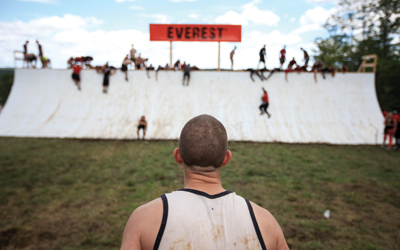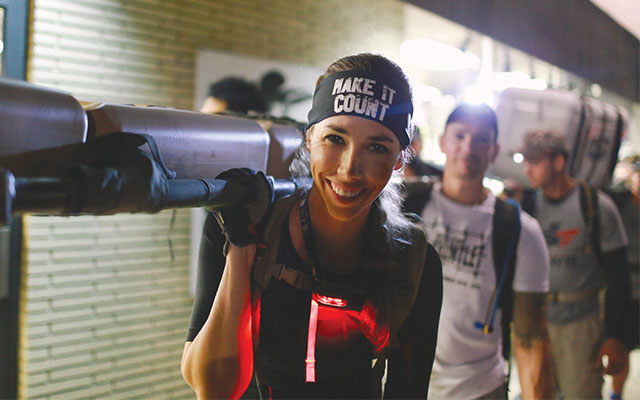Twelve years ago, Evelyn Spence was looking for a challenge. So the Seattle-based writer strapped on her tennis shoes and signed up for the Rock ’n’ Roll Marathon in San Diego, which just happened to be raising money for cancer research.
“Back then, I had no connection to the cause,” says Spence, 36. “I did it for the support and coaching to train for my first marathon,” she remembers. “It was very social, very attainable, and I had a great time.”
A few years later, Spence’s father, Alex, was diagnosed with chronic lymphocytic leukemia, and the concept of exercising for a charity suddenly became a matter of life and death. “In the fall of 2009 his cancer came back more aggressively than ever,” Spence says of the disease’s relentless evolution. “The connection to the cause felt much stronger and even desperate, and the generosity of people was incredible. I think people wanted to feel like they were doing something to help an impossible situation.”
Alex died while his daughter was training for the 2010 Wildflower Triathlon’s half-ironman in Lake San Antonio, Calif. Fueled by equal parts grief, pride and love, Spence found the inspiration to finish what she had started. And she’s been running, swimming and biking for the cause ever since.
“It’s one way I can feel proactive — and cope — even years later,” she says. “While I trained, I found that I thought about him often when I was tired, or when I didn’t want to get up early for a rainy bike ride. I realized no matter how long and steep the hill is when I’m riding, it’s nothing compared with what those with cancer go through on a daily basis.”
Spence’s perspective turned out to be contagious, and she’s since convinced friends and colleagues to contribute financially and physically to a variety of similar charity events. “In my experience, people get emotionally involved no matter what, and it adds a really rich dimension to what is already a great challenge,” she says.
Whether you’re running in honor of a family member or to raise awareness for an issue near and dear, organized athletic events are a surefire way to increase your fitness and motivation, says Andrew Feast, assistant vice president of special events for the American Lung Association in Washington, D.C. They also even the playing field, putting people together at different fitness levels in pursuit of a common goal. “Teams and individuals can use the event as a fitness target or a race,” he says. “It’s a great way to be active and meet new friends.”
In the context of a cause, the finish line looks closer and takes on greater meaning. What’s more, once people realize the process doesn’t have to be painful — that it can actually be fun — they often want to compete in future events, where healthy, supportive communities emerge around cause-oriented goals.
“It’s an opportunity to make friends and have fun as part of a supportive team,” says Andrea Greif, director of public relations for the Leukemia & Lymphoma Society in White Plains, N.Y., which puts on Team In Training events nationwide. “There’s immense satisfaction in supporting cancer research and helping patients live better, longer lives.”
Thanks to the feel-good environment and focused sense of purpose, participants reap rich physical and psychological benefits beyond the walking, running, climbing and biking that takes place at the events themselves. Even those who choose to provide sideline support stand to get back far more than they put in. The Corporation for National and Community Service reviewed studies from sources like Duke University to look at the correlation between volunteering and physical health. Their discovery: Virtually any kind of volunteer activity can reduce intensity levels of chronic pain, lower rates of depression and reduce mortality risk. The social ties it creates can even improve immunity.
There are a number of well-established highly publicized events (such as Team In Training and the Susan G. Komen Race for the Cure Series) that raise money and awareness for cancer research. But there are also thousands of other events held across the country each year on behalf of everything from curing autism to cleaning up the environment.
Large and small, local and national, they all raise awareness and establish connections between people as diverse as the causes they care about.
Since it can be hard to choose, we’ve outlined just a few lesser-known examples on the following pages. We selected three groundbreaking events — one easy, one challenging, and one unusual — with wide-reaching causes and strong fitness elements. You can find many more in your community, or even organize a cause-related event of your own.
Either way, says Spence, be prepared for the inevitable: “Once you’ve completed one event, you’ll want to sign up again and again.”
Low Stress
Run Walk Hope 5K
- When: June 8, 2013
- Where: Worldwide
- Why: To support widows and widowers and their children
- How: Sign up at www.thelizlogelinfoundation.org/events/5k. All registration fees go to the foundation, and participants can also fundraise (there’s no minimum amount).
Matt Logelin knows a little something about transforming grief into giving. On March 24, 2008, Logelin and his wife, Liz, welcomed their first child, Madeline, into the world. Just 27 hours later, Liz suffered a pulmonary embolism and died suddenly. Logelin, who tells the story in his best-selling memoir, Two Kisses for Maddy: A Memoir of Loss & Love (Grand Central Publishing, 2011), initially wasn’t sure he would survive the loss.
“My thoughts went straight to Madeline, alone in that NICU, completely unaware of how drastically our lives had just changed. . . . Holding her, I knew I was going to have to figure things out for her sake,” he writes. Day by day, Matt focused on feeding and nurturing his newborn daughter. Almost immediately, he received help, an outpouring of gifts (toys, diapers, money) and support through his blog at MattLogelin.com. “To have total strangers giving us stuff and wanting to make sure we’re OK all the time was just incredible,” he says.
Matt’s instinctive response was to find a way to give back. He took the money he’d been given and established the Liz Logelin Foundation, which helps widows and widowers with monetary grants regardless of age, sexual orientation or marital status. The money helps these families — many of them young and without life insurance — with essentials like groceries, rent, children’s clothing and mortgage payments.
With the help of his blog followers, Logelin organized the Run Walk Hope 5K, which has grown to become a worldwide event with 1,300 participants. “I wanted to find a way not only to honor my late wife, who was a runner, but to give back to the community of people I’d reluctantly found myself a part of,” he says.
What makes the Run Walk Hope 5K unique is that people can participate on the same day, at the same time, anywhere in the world, regardless of their fitness level. Participants can sign up online and run or walk with other supporters in their community, no matter where they are. Logelin says the event has helped people who are grieving find local support, and has given them a reason to get out of bed, get outdoors and be active.
High Intensity
Tough Mudder
- When: Several times a year
- Where: Worldwide
- Why: To support wounded veterans
- How: Go to www.toughmudder.com to find an event, forums and training schedules.
Roland Britton III, of Dinwiddie, Va., wanted to serve in the military, but a chronic injury prevented him from joining. “Knee surgery kept me out, and I was angry when I was denied,” he says. But at age 27, Britton discovered the Tough Mudder, a boot-camp-style endurance event that benefits the Wounded Warrior Project (WWP), a nonprofit that aids and empowers wounded veterans.
“The WWP was a huge draw for me,” he says. “I am a big supporter of men and women in uniform, and especially those who have sacrificed so much for our country.”
More than 48,000 troops have been wounded during the military conflicts in Iraq and Afghanistan. Hundreds of thousands more are recovering from posttraumatic stress disorder (PTSD), depression and traumatic brain injury (TBI). To date, Tough Mudder events have raised more than $3.5 million for the charity. Events take place in several cities throughout the United States, Canada, Europe, Japan, South Africa, New Zealand and Australia.
Unlike many other endurance events or mud runs, Tough Mudder events are designed by British Special Forces and feature 10 to 12 miles of trail running, steep inclines, water hazards, and between 18 and 28 military-style obstacles like trenches, walls, underwater tunnels and barbed wire.
Despite the intensity of the course, the event is not a race. Participants are not timed. To win is to simply cross the finish line. “I signed up because I wanted to challenge myself in a way I’d never been challenged before,” says Melissa Dant, 44, who at press time was training for her second Tough Mudder in Las Vegas. “It’s amazing how much people are willing to help each other on the course,” she says. “You can’t actually get through it without help from others.” As a result, she says, participants form bonds that last long after the event is over.
To highlight that camaraderie, race organizers invite teams of wounded veterans to participate in every race. It’s a strong visual reminder to participants that they’re helping a great cause. And it’s a great motivator, Britton adds. “I know if they can get through the course, so can I.”
One of a Kind
Fight for Air Climb
- When: Several times a year
- Where: Most major cities
- Why: To benefit the American Lung Association
- How: Go to www.lung.org/donate/events/fight-for-air-climb and click on the map to find an event.
Climbing several flights of stairs can give you a new perspective in more ways than one. It certainly makes your lungs burn, which is exactly what the Fight for Air Climb is all about. Sometimes called a “vertical road race,” the climbs take participants to the top of One Boston Place, Kansas Speedway, Chicago’s Presidential Towers, and many other famously tall landmarks. The events support the American Lung Association, which provides education, research and advocacy for anyone suffering lung diseases, including cancer, asthma, emphysema, chronic bronchitis or the effects of secondhand smoke.
With each step, participants are reminded that there are millions of people who struggle each day to breathe. The finish line offers a great view and a lot of hope for those who benefit from the fundraising climb, according to Mike Townsend with the American Lung Association. Lung diseases are especially brutal and in desperate need of more funding and research, he says.
Fortunately, awareness and support are expanding several steps at a time. “The number of climb events has grown from 25 in 2008 to 60 in 2012,” says Andrew Feast, assistant vice president for special events for the American Lung Association. “Fight for Air Climbs bring together families, corporate teams, police and firefighters, athletes, and community organizations to one venue.”
Bill Spencer participated in a climb on behalf of his two young children, to give them hope that, despite having severe asthma, they can accomplish anything. “Rachel is 4 and John is 3, and they started breathing treatments for asthma before they were a year old,” Spencer says. “We want them to explore, experience, try as many things as they can and never be held back by anything. We participate as a family to make a difference.”
Eighty-one cents of every dollar people raise for the Fight for Air Climbs goes directly to the American Lung Association. Many cities have corporate sponsors that offer matching donations, so even the smallest teams can make a big difference. Participants can climb solo or as a relay team, making this a charity event for all abilities.
Choose Your Charity
Before you plunk down cash or solicit pledges for an event, take a closer look at the organizations it benefits and decide if you like the way they operate and spend their proceeds.
1. Stop by CharityNavigator.org or GuideStar.org, which independently evaluate charities for their accountability, transparency and expense ratios.
2. Understand the group’s work. Is its mission to build community around an issue, educate, or raise money for grants or research? There’s no right or wrong answer; just make sure you agree with what the charity is doing.
3. Are donations tax deductible? The IRS maintains a list of all exempt organizations: http://apps.irs.gov/app/eos.
4. Don’t be afraid to ask questions. Charities are required to provide information about their budgets and expenses. They should be able to answer basic inquiries like: How will my donations be spent? How many people did you help last year?|
More Great Events
More charity races for good causes, from sea to shining sea.
Commitment: High
Climate Ride (California): 300-mile, five-day ride along the California coastline
Cause: Renewable energy and environmental charities; www.climateride.org; May 2013 (East Coast, September 2013)
Challenge Four Adventure Race (Georgia): 20 miles of running, biking, paddling, orienteering
Cause: Underprivileged kids through the YMCA;www.challengefour.org; spring 2013
Summit for Someone (Wyoming): Two- and three-day climbs
Cause: Big City Mountaineers (at-risk youth); www.summitforsomeone.org; August 2013 (other dates, locations and difficulty levels worldwide)
Commitment: Medium
5K Foam Fest (Washington): 5K run with obstacles
Cause: Shared Hope International (works to end sexual slavery worldwide) and local charities; www.5kfoamfest.com; June 2013 (other dates and locations nationwide)
Bike MS: Pedal los Pueblos (New Mexico): Two-day ride
Cause: Multiple Sclerosis; www.nationalmssociety.org/racemap.aspx; August 2013 (other dates, locations and distances nationwide)
Swim Across Boston Harbor (Massachusetts): 22-mile relay (swum in 15-minute heats)
Cause: cancer; www.swimacrossamerica.org; July 2013 (other dates, locations and distances nationwide)
Commitment: Low
AIDS Walk (New York): 10K walk
Cause: AIDS service organizations; www.aidswalk.net; May 2013 (other dates and locations nationwide)
Pushups for Charity (Arizona): As many pushups as you can do in 90 seconds
Cause: The Boot Campaign (supports veterans and military heroes); www.pushupsforcharity.com; May 2013 (other dates and locations nationwide)
The Color Run 5K (Florida): 5K run, where runners get decorated by spectators
Cause: Local organizations such as youth charities and homeless shelters; www.thecolorrun.com; December 2012 (other dates and locations nationwide)|
Do-It-Yourself
Thanks to social media and a host of online portals, starting your own charity event is easier than ever. Here are a few tips to help you succeed.
Know what you’re getting into. Focus on the cause that tugs at your heartstrings the most. You need to feel inspired on a deep level, because organizing an event will take a lot of your time and energy.
Get permission. Landowners, cities and public-land agencies are often open to allowing a nonprofit event on their turf. Chart your course; find out what agencies manage the land, trails or roads; and then get a permit.
Partner with a reputable nonprofit organization. This will allow donors to write off gifts, which makes fundraising easier.
Snag sponsors. Hit up local restaurants for postrace snacks, local gyms for cross-promotion deals on coaching and clinics, or a gear shop to provide prizes for the participants who raise the most money.
Find volunteers. You’ll need all the help you can get. Entice volunteers with a free T-shirt or VIP access to postrace food and entertainment.
Create an online presence. Sites like Active.com and JustGiving.com offer online giving modules for charity events.
Other sites to try:
Kickstarter
www.kickstarter.com
Fundrazr
www.fundrazr.com
Crowdrise
www.crowdrise.com
Plus 3 Network
www.plus3network.com




This Post Has 0 Comments